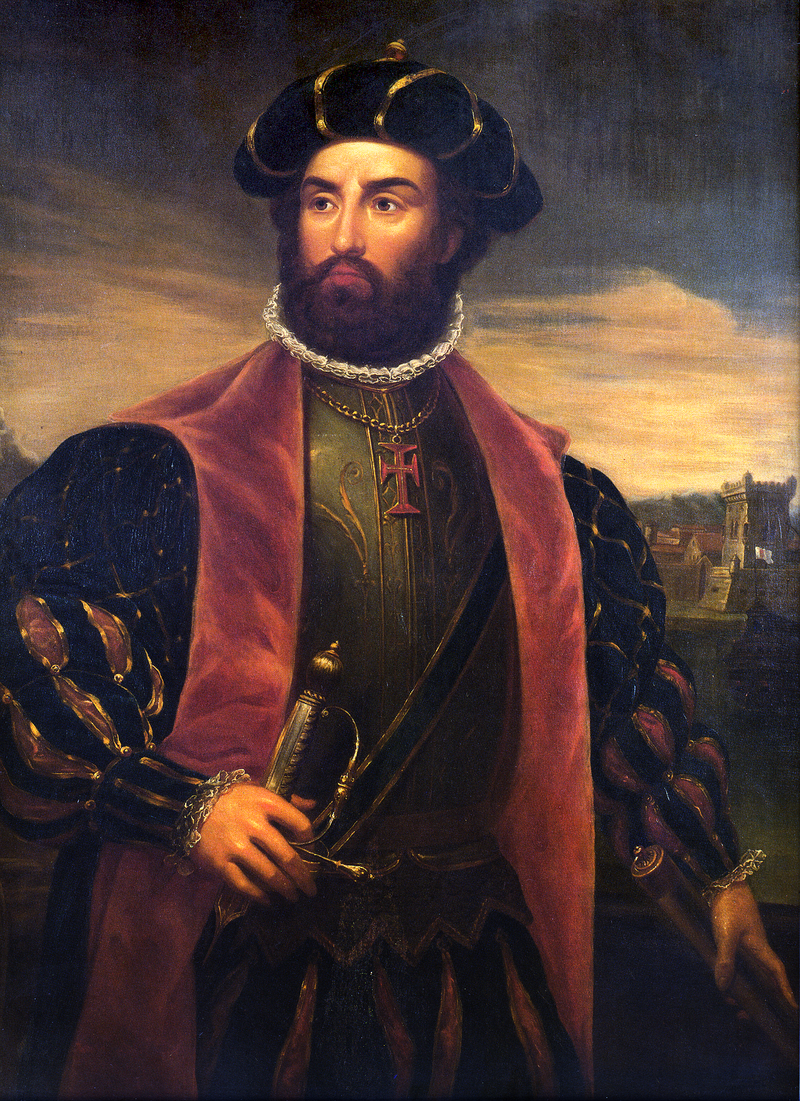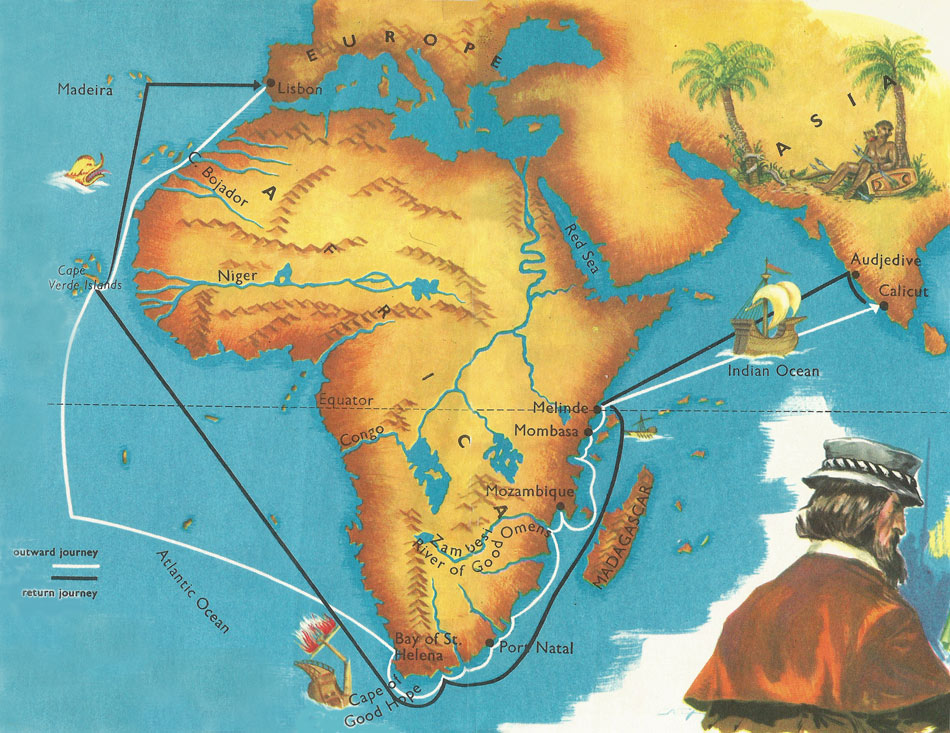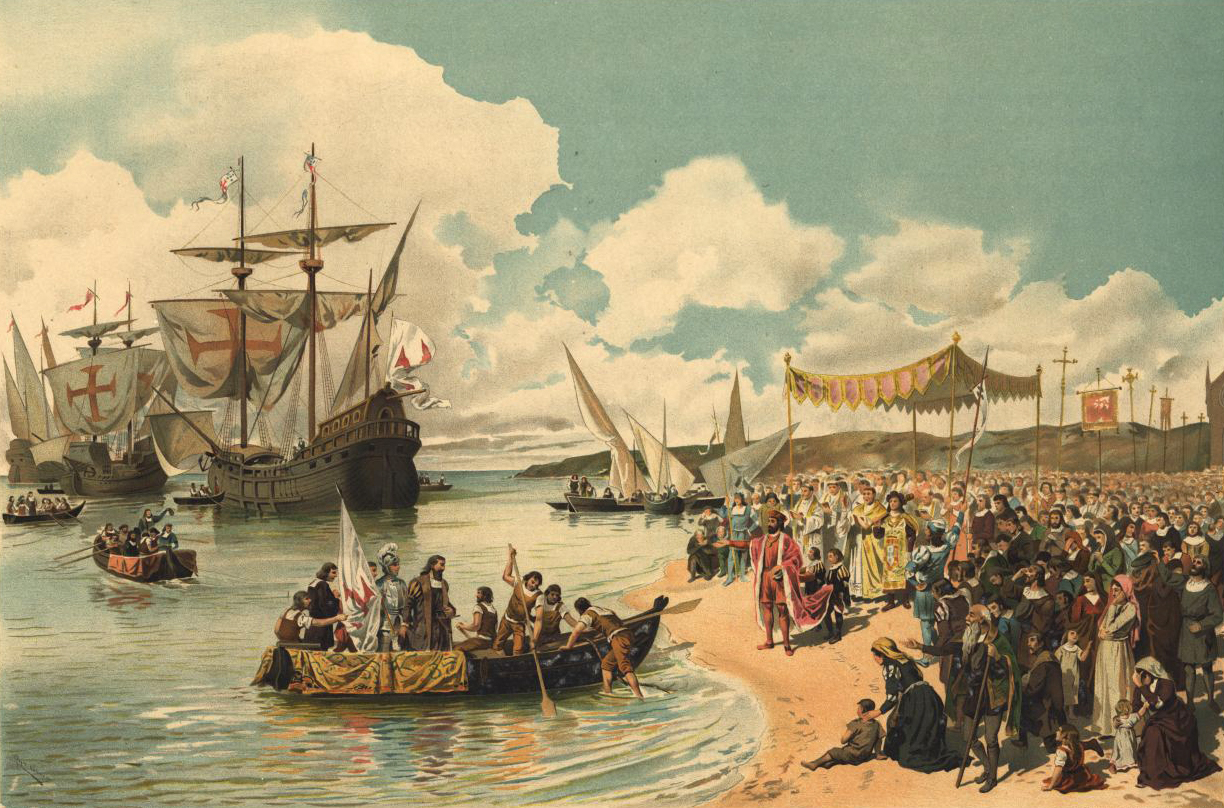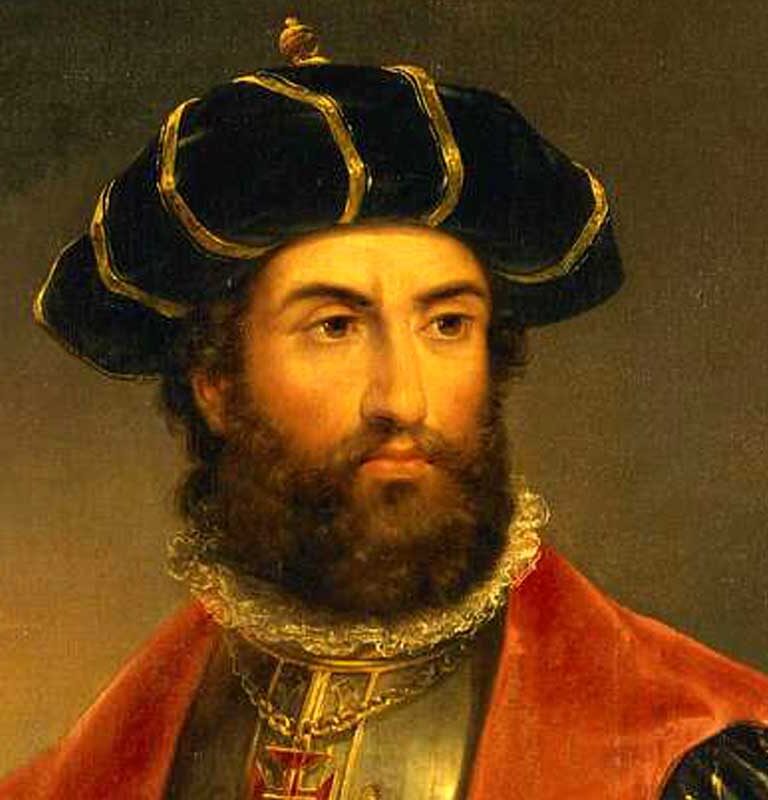Vasco da Gama’s journey to India not only redefined the world’s commercial landscape but also solidified his legacy as a trailblazing explorer whose audacious voyages navigated history’s uncharted waters. The pivotal role of Vasco da Gama in establishing the sea route to the East continues to be celebrated as a testament to human curiosity, determination, and the enduring spirit of exploration.
The Sea Route to India
Vasco da Gama, a legendary Portuguese explorer, left an indelible mark on the Age of Discovery. His maritime expeditions, undertaken between 1497 and 1524, charted a course that forever altered the world’s trade routes. Da Gama’s most renowned achievement was his pioneering voyage to India via the treacherous Cape of Good Hope, a feat that opened the coveted sea route from Western Europe to the riches of the East.
Early Life and Origins
Vasco da Gama’s early life remains shrouded in relative obscurity. He was the third son of Estevo da Gama, a lesser-known provincial figure who held the position of commander of the fort of Sines, situated off the coast of Alentejo province in southwestern Portugal. The details of his formative years are scarce, leaving historians with tantalizing gaps to speculate upon.
The French Interception Mission
In 1492, da Gama’s trajectory took an intriguing turn when King John II of Portugal dispatched him on a mission to the region of Setúbal, situated south of Lisbon. His mission was twofold: to patrol the waters off Algarve, the southernmost province of Portugal, and intercept French ships. This mission was in retaliation for perceived encroachments by the French on Portuguese interests. Da Gama executed this task with exceptional swiftness and efficiency, establishing his early reputation as a capable mariner.

The Ascension of King Manuel
The year 1495 marked a significant turning point in Portuguese history with the ascent of King Manuel I to the throne. This change in leadership heralded a shift in the balance of power within the Portuguese court, favoring the friends and patrons of the da Gama family. Simultaneously, it reignited a long-neglected project: the quest to establish a direct maritime route to Asia, specifically to secure access to the lucrative spice trade.
Furthermore, Portugal sought to challenge Muslim dominance in the exclusive Indian Ocean trade. For reasons that remain somewhat enigmatic, Vasco da Gama, who possessed limited relevant experience in maritime matters, was entrusted with the momentous responsibility of leading this ambitious expedition.
Setting Sail from Lisbon
The monumental expedition led by Vasco da Gama commenced on July 8, 1497, setting sail from Lisbon with a fleet of four ships. This fleet was a diverse ensemble of vessels, including two medium-sized three-masted ships, each boasting a capacity of approximately 120 tonnes, named “Sao Gabriel” and “Sao Raphael.” Alongside these, a 50-ton caravel, fittingly dubbed “Berriero,” added its maritime prowess to the mission.
Notably, a substantial 200-ton storeship accompanied them, holding essential supplies and provisions for the arduous journey. Additionally, the expedition featured a team of interpreters, comprising two Arabic speakers and one fluent in several Bantu dialects, demonstrating the significance of linguistic versatility for navigating diverse regions. The cargo also included padres, and stone pillars intended to be erected as symbols of discovery, reflecting the grand ambition of their undertaking.
Navigation Challenges and Strategic Delays
The fleet’s navigational course was laden with challenges and intricacies. After passing through the Canary Islands on July 7, the expedition reached Sao Tiago (Santiago) in the Cape Verde Islands by July 26, where they paused until August 1. This brief respite allowed for preparations and final adjustments before venturing further into the unknown.
Da Gama’s strategic acumen came into play as they deviated from the customary route, steering clear of the formidable Gulf of Guinea. Instead, they embarked on a more circuitous journey through the South Atlantic, a decision aimed at optimizing their chances of safely rounding the Cape of Good Hope.
A Protracted Quest Towards the Cape
The quest to reach the Cape of Good Hope was a protracted one, with numerous obstacles to overcome. The fleet finally anchored in Santa Helena Bay, a location in modern-day South Africa, on November 1. However, their progress was hindered by adverse winds and the challenging currents of the region. These formidable natural forces conspired to delay their arrival at the coveted Cape of Good Hope until November 22, a testament to the daunting nature of the voyage.
Establishing a Foothold in Mossel Bay
With their determination unwavering, Vasco da Gama and his intrepid crew forged ahead. Three days following their eventual arrival at the Cape of Good Hope, they established a significant foothold in Mossel Bay. Part of their strategic plan was to dismantle the storeship and island, a calculated move to optimize their resources for the challenges that lay ahead.
Vasco da Gama’s historic expedition was marked by navigational daring, meticulous planning, and the unrelenting pursuit of their ultimate goal: to establish a direct sea route to the riches of the East. This epic journey, filled with triumphs and tribulations, would ultimately reshape the course of history and lay the foundation for future maritime exploration and trade. Learning Language Guide, Speaking, Reading, Writing, Listening Skills
Reaching the Coast of Natal
As Vasco da Gama’s expedition continued its arduous journey, they reached the coast of Natal on Christmas day, December 25. Their tenacity and navigational prowess had brought them this far, but the challenges were far from over. On January 7, the expedition anchored near the mouth of a small river, situated between Natal and Mozambique, naming it the “Rio du Cobar” or Copper River. This was a momentous juncture in their voyage, marking their proximity to the eastern shores of Africa.
Discovering the Rio dos Bonas Sinis
January 26 saw the expedition’s arrival at Mozambique, known today as Mozambique. Here, they navigated the Klemen River, naming it the “Rio dos Bonas Sinis” or Good Woman’s River, and established another important base. However, this period was characterized by the crew’s affliction with scurvy, a common ailment among long maritime journeys. Recognizing the need for recuperation and repairs, the expedition took a month’s respite to tend to their sick and restore their vessels.
Encounters in Mozambique
On March 2, the expedition reached Mozambique Island, where they encountered residents who initially believed the Portuguese to be Muslims due to their unfamiliar appearance. It was here that Vasco da Gama learned about the local trade dynamics with Arab merchants and the presence of four Arab vessels laden with valuable cargo, including gold, jewelry, silver, and spices. Notably, the mention of Prestor John, a long-standing Christian ruler, piqued their interest in exploring further into the interior, where many coastal cities thrived.
A Sultan’s Assistance and Pilots
The Sultan of Mozambique offered valuable assistance to Vasco da Gama’s expedition, providing them with two experienced pilots. However, one of these pilots, upon realizing that the Portuguese were Christians, decided to desert. This event underscored the complex web of cultural interactions and misunderstandings that characterized these early encounters between European explorers and the peoples of Africa and Asia.
Advancing to Mombasa and Malindi
In April, the expedition reached Mombasa, a prominent coastal city that is now part of Kenya. This marked a significant milestone in their journey. Later, on April 7, they anchored in Malindi, another coastal town in what is modern-day Kenya. Here, they welcomed a Gujarati pilot who was en route to Calicut in southwestern India. This pilot’s presence would prove invaluable as they continued their voyage across the vast expanse of the Indian Ocean.
Arrival in Calicut, India
The culmination of their efforts came on May 20 when the expedition arrived in Calicut, India. This historic moment was reinforced by the presence of a clergyman, providing irrefutable proof that Vasco da Gama had successfully reached the fabled shores of India. This achievement marked the completion of a monumental maritime voyage that would have profound implications for the history of trade, exploration, and global connectivity.
Vasco da Gama’s journey, fraught with challenges, marked a pivotal chapter in the age of exploration, as it opened up new trade routes and cultural exchanges that would shape the course of history.

Zamorin’s Discontent and Failed Deal
As Vasco da Gama’s expedition reached Calicut, the prominent trading center of South India, they encountered the Hindu ruler Zamorin. However, the initial exchange was far from favorable. Zamorin was unimpressed by Da Gama’s meager gifts and perceived rudeness, setting a challenging tone for their interactions.
Da Gama’s mission to strike a deal faced significant hurdles, partially due to his hostility toward Muslim merchants and partly because the goods he had brought, characterized as trumpery and unsuitable for the Indian market, were in low demand. A critical misunderstanding also arose, as the Portuguese mistakenly believed that the Hindus they encountered were Christians. Travel essentials, accessories, kit & items on Amazon
Escalating Tensions and Departure
As tensions between the Portuguese and locals escalated, Da Gama decided to bring five or six Hindus with him back to King Manuel, with the intention of providing insights into their customs. However, his lack of local knowledge and disregard for the monsoon seasons led to an ill-timed departure, forcing them to navigate against the heavy rains.
Da Gama’s journey took him to Anjidibe Island near Goa before embarking on the voyage to Malindi, which they reached on January 8, 1499, after nearly three months at sea. The grueling conditions and shortages of essential supplies resulted in the loss of many lives during this leg of the journey.
Establishing Footholds and Final Leg
In Malindi, with a significantly reduced crew, Da Gama ordered one of his ships, the “Sao Raphael,” to be burned. Here, he also established another crucial outpost. The expedition continued its journey, reaching Mozambique, where they secured their last foothold in their extensive travels.
Separation and Arrival in Lisbon
On March 27, 1499, the remaining vessels, “Sao Gabriel” and “Berrio,” approached the Cape of Good Hope. However, after enduring a storm, they became separated. “Berriero” ultimately arrived on the Tagus River in Portugal on July 7, while “Sao Gabriel” continued its journey, eventually anchoring on the Azores island of Teresita. From there, Da Gama sent his flag to Lisbon, marking his imminent return.
Legacy and Honors
Vasco da Gama’s remarkable journey culminated when he himself arrived in Lisbon on September 9. Nine days later, he entered the city to great acclaim, though it was marred by the mourning of his brother Paolo, who had passed away in Teresita. Among the survivors of the original crew, only four out of four hundred remained.
King Manuel I of Portugal recognized Da Gama’s historic achievement by granting him the title of Dom and bestowing upon him an annual pension of one thousand cruzados, along with significant estates. Vasco da Gama’s indomitable spirit and determination in navigating the treacherous seas and forging new maritime routes left an enduring legacy that would impact global trade and exploration for centuries to come.
Setting Sail from Lisbon (July 8, 1497)
On July 8, 1497, Vasco da Gama embarked on a monumental journey from Lisbon, Portugal, leading a fleet of four ships. The flagship, “Sao Gabriel,” was under his direct command, while his brother Paolo da Gama took charge of three other vessels, including the “Sao Raphael.” The fleet also included the caravel “Berrio” and the storeship “Sao Maria.” Accompanying them was the experienced navigator Bartolomeu Dias, whose knowledge would prove invaluable in navigating the treacherous African coast. They made their first stop in the Canary Islands, reaching the Cape Verde Islands by July 2.
Strategic Moves and Challenges (July – November)
After a brief stay in the Cape Verde Islands, Da Gama’s fleet set sail again on August 7. To avoid the turbulent storms and strong currents near the Gulf of Guinea, they charted an unconventional route, venturing across the South Atlantic en route to the Cape of Good Hope. Despite their strategic move, they still faced the wrath of unpredictable storms that delayed their progress. It wasn’t until November 22 that they finally sighted and successfully rounded the Cape of Good Hope, anchoring in Mossel Bay, South Africa, just three days later.
Navigating the African Coast and Health Issues (December – March)
Continuing their journey, they sailed further north along the African coast, anchoring near the Rio do Cobre (Copper River) in Mozambique in January. Their next destination was the Rio dos Bonas Sinaiis (River of Good Woman) where they erected a marker called Portugal. Here, their progress was hindered for a month as scurvy, caused by a lack of vitamin C, afflicted a significant portion of the crew.
Resuming the Voyage and Arrival in India (March-May)
Da Gama’s fleet finally resumed its journey on March 2, reaching Mozambique, where they engaged in trade with local Muslim merchants. They then made their way to Malindi (now in Kenya), where they secured the services of a pilot to navigate the Indian Ocean. After 25 days at sea, they sighted the Ghats of India, and on May 20, 1498, they reached the shores of India, marking a historic milestone.
Challenges in Calicut and Departure (May-August)
Upon their arrival in Calicut, Da Gama sought an audience with the local king, but his initial gifts and diplomatic gestures failed to impress. This led to challenges in establishing trade relations. Da Gama and his crew spent several months conducting business and studying Indian customs. By the end of August, they made the decision to depart from India.
Final Stops and Return to Portugal (August – September)
Before heading back to Portugal, Da Gama’s journey included a visit to Anjidibe Island near Goa. They also made a brief return to Malindi on January 5, 1499, where they made the difficult decision to burn the “Sao Raphael” to prevent further illness among the crew. Ultimately, Da Gama and his fleet returned to Portugal on September 9, 1499.
Honors and Recognition
Vasco da Gama’s remarkable achievement did not go unnoticed. King Manuel I of Portugal, recognizing the significance of his voyage, bestowed upon him the titles of Dom and Admiral and granted him a substantial annual pension. Vasco da Gama’s daring expedition not only opened up new maritime routes but also expanded the horizons of Portuguese exploration and trade. Learn English Guide, Speaking, Reading, Writing, Listening Skills
Marriage and Family Life (1500)
In 1500, shortly after his return from his first historic voyage to India, Vasco da Gama married Katrina de Ataid. The couple settled in their hometown and had six sons. During this time, da Gama continued to play an advisory role in matters related to India, leveraging his knowledge and experience.
Challenging Ventures (1502)
Vasco da Gama’s subsequent expeditions to India were marked by increasingly complex and, at times, hostile interactions with the people he encountered. In February 1502, he set sail with a formidable fleet of 150 ships. Along the way, they made strategic stops, including the Cape Verde Islands and Mozambique. As they sailed further, they reached Kilwa, located in modern-day Tanzania. Here, Da Gama resorted to intimidation tactics, compelling the local leader and his men to swear allegiance to the King of Portugal.

Conflict and Confrontation (Calicut and Cochin)
Upon reaching Calicut, Vasco da Gama’s approach took a violent turn. He launched an attack on the port, resulting in the deaths of numerous Muslim merchants. His actions further escalated tensions in the region. Cochin witnessed clashes between Portuguese forces and Arab ships, with the latter being sent into disarray. Vasco da Gama’s actions during these expeditions were laying the groundwork for the expansion of the Portuguese Empire into the Indian subcontinent.
Challenges and Homecoming (1503)
Vasco da Gama faced challenges during his voyages, including difficult interactions with East Africans and South Asians. As his third expedition unfolded, Da Gama eventually set sail for his return home on February 20, 1503, and arrived back in Portugal on October 11, 1503. In the midst of these events, King Manuel I, who had been a patron of Da Gama’s voyages, passed away in 1521, ushering in a new era of Portuguese leadership.
Appointment as Portuguese Viceroy of India (1524)
In recognition of Vasco da Gama’s contributions and experience, King Manuel I’s successor, the third Portuguese king, appointed him as the Portuguese Viceroy of India. His role included overseeing efforts to halt the fortification of Indian territories by other European powers and addressing administrative issues involving Portuguese officers stationed in India. Self Development, Productivity, Time Management, Happiness.
Conclusion of Da Gama’s Voyages (1503)
Vasco da Gama’s third voyage marked the conclusion of his legendary expeditions. His impactful and often controversial actions paved the way for Portugal’s expansion into India and the establishment of its colonial presence in the region.
Vasco da Gama’s Return to India and Leadership (1524)
In 1524, Vasco da Gama embarked on another journey to India, leaving Portugal behind. He arrived in Goa on September 7, where he took on a prominent role in restoring order and governance among the Portuguese leaders in the region. His leadership and experience were crucial during this phase of Portuguese expansion in India.
Illness and Passing (December 24, 1524)
Tragically, at the end of the year, Vasco da Gama’s health began to deteriorate. On December 24, 1524, in Cochin, India, the great explorer passed away. He was laid to rest in the local church. In 1539, his remains were repatriated to Portugal as a mark of honor and respect for his contributions.
Legacy and Impact
Vasco da Gama’s legacy is profound and enduring. As the first European to successfully establish a sea route to trade with India, he achieved what countless explorers before him had aspired to but could not accomplish. His groundbreaking discovery of the sea route around Africa opened the door for Portugal to establish a long-lasting colonial empire in both Asia and Africa.
This newfound access to the Indian spice route greatly enriched Portugal’s economy and secured its position in global trade. Vasco da Gama’s pioneering travels and explorations not only changed the course of history for Europeans but also opened up a new world of riches through the Indian Ocean route. His enduring impact is a testament to the spirit of exploration and discovery that shaped the Age of Exploration.
More Interesting Articles
- 5 Valuable Life Lessons to Remember from Great Persons
- 6 Inspirational Life Lessons to Remember for a Better life
- 8 Great Life Lessons from Alexander the Great Famous Quotes
- 5 Realistic Inspiration for Living from Successful Leaders
- 7 Realistic Life Lessons from Quotes by Franklin D. Roosevelt
- 5 Motivational Tips for Journey to Life from Great People
- 6 Life Lessons for Inspiration in Tough Times from Great People
- 7 Important Life Lessons from Legends to Remember
- 7 Never Forgettable Life Lessons Learned the Hard Way
- 38 Roy Fox Lichtenstein Pop Artist Interesting Fun Facts
- 22 Henry Hudson American Explorer Interesting Fun Facts
- 36 Henry Ford Entrepreneur Interesting Fun Facts
- 10 Greatest Military Commanders of All Time Interesting Facts
- 40 Interesting Fun Facts about Egyptian Queen Cleopatra
- 30 Surprising Mary Queen of Scots Interesting Fun Facts
- 38 Maya Angelou Activist Writer Interesting Fun Facts
- 26 Adam Smith Father of Economics Interesting Fun Facts
- 29 Philosopher Rene Descartes Interesting Fun Facts
- 10 Fun Interesting Facts about Aristotle Greek Scientist
- 10 Interesting Fun Facts about Archimedes Greek Mathematician
